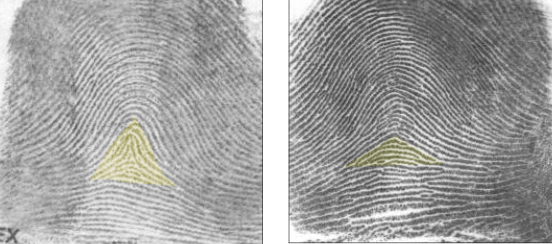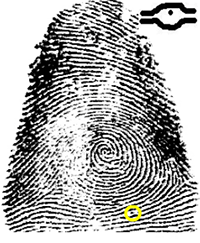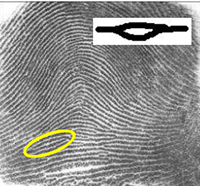Lesson
Fingerprints are an excellent piece of physical evidence when found at a crime scene. Unlike DNA, even identical twins do not have the same fingerprints.
Fingerprints aren’t found easily or look as perfect as fingerprints on the TV shows. Partial fingerprints can be smudged and difficult to identify when found at a crime scene.
After finding a partial print at a crime scene, the fingerprint is put into a database called AFITAdvanced Fingerprint Identification Technology. This system, part of the Next Generation Identification (NGI) system, stores and retrieves fingerprints of past offenders. Matches are not always found through AFIT but if a match is found in the system, someone makes sure the two prints match using a magnifying glass. Read more at FBI: Next Generation Identification.
AFIT Key Facts
- Contains fingerprints, identification marks (such as tattoos, scars, etc.), weight, height, eye color, etc.
- It also contains civil prints (such as people who serve in the military)
- Prints in database:
- 70 million criminal prints
- 34 million civil prints
- 73,000 known and suspected terrorists
Fingerprints contain both class and individual characteristics. We will talk first about three different patterns of fingerprints. These patterns are considered class characteristics because many people have the same types of fingerprints. These characteristics can be linked back to a group of people, but not one specific person, place, or thing. The three types of fingerprint are arch, loop and whorl. Within each type of fingerprint there are different types of arches, loops, whorls.
Tented arches are more pointed compared to a plain arch.

Image on left is a tented arch, while the image on the right shows a plain arch.
There are two different types of loops: radial loop and an ulnar loop. An ulnar loop enters and exits near the pinky where the radial loop enters and exits toward the thumb. These two types can be very confusing to students.
There are three different types of whorls, a plain whorl, central pocket whorl, a double loop whorl and an accidental whorl. Each of these is different in its own way.
A central pocket whorl is a much tighter whorl compared to the plain whorl. A double loop whorl has two loops within it and an accidental whorl includes any whorl that doesn’t fit into the other three types of whorls.

From left to right: central pocket whorl, plain whorl, and double loop whorl
The fingerprint minutiae (AKA ridge characteristics) can be linked to one specific person. This makes it individual evidence. No two people will have the exact same minutiae characteristics, not even identical twins. Read more about minutiae at Ridge Characteristics. There are several types of minutiae found in each print. This is what makes them unique. They are as follows:
| Ridge Dot |  |
|
| Bifurcation | One friction ridge branches off and divides into two friction ridges |  |
| Trifurcation | Looks like a pitch-fork Branches off into 3 ridge lines |
 |
| Ending Ridge | Where the ridge stops |  |
| Ridge Crossing | Where 2 ridges cross – forms an X |  |
| Encloser (lake) | When a ridge breaks into 2 and then joins back into one a short time later. Looks like an oval or an eye |
 |
| Short Ridge (island) | A short ridge |  |
| Spur (hook) | Looks like a hook coming off of another ridge |  |
| Bridge | When a ridge connects two ridges – like a bridge |  |
Look at the picture below and identify the different minutiae. The number of minutiae that are required to match between two prints varies. Criminal courts require 8 to 12 minutiae to match.

When a person is arrested, he or she can count on being fingerprinted. Those prints will not go into the system unless the person is found guilty of the charges. Messy ink is no longer used when fingerprinting. Inkless methods are now used, such as live-scan sensory methods. You simply roll your fingers across a glass plate and they are scanned into a computer.
